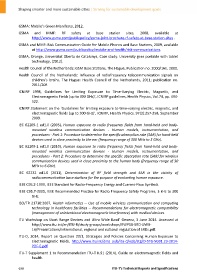Page 648 - Shaping smarter and more sustainable cities - Striving for sustainable development goals
P. 648
GSMA: Mobile’s Green Manifesto, 2012.
GSMA and MMF: RF safety at base station sites, 2008, available at
http://www.gsma.com/publicpolicy/gsma‐joint‐brochure‐rf‐safety‐at‐base‐station‐sites .
GSMA and MMF: Risk Communication Guide for Mobile Phones and Base Stations, 2009, available
at http://www.gsma.com/publicpolicy/mobile‐and‐health/risk‐communications.
GSMA, Orange, Universitat Oberta de Catalunya, Case study: University goes portable with tablet
technology, (2012).
Health Council of the Netherlands: GSM Base Stations, The Hague, Publication no. 2000/16E, 2000.
Health Council of the Netherlands: Influence of radiofrequency telecommunication signals on
children’s brains. The Hague: Health Council of the Netherlands, 2011; publication no.
2011/20E.
ICNIRP 1998, Guidelines for Limiting Exposure to Time‐Varying Electric, Magnetic, and
Electromagnetic Fields (up to 300 GHz)’, ICNIRP guidelines, Health Physics, Vol.74, pp. 494‐
522.
ICNIRP Statement on the ‘Guidelines for limiting exposure to time‐varying electric, magnetic, and
electromagnetic fields (up to 300 GHz)’, ICNIRP, Health Physics, 97(3):257‐258, September
2009.
IEC 62209‐1 ed1.0 (2005), Human exposure to radio frequency fields from hand‐held and body‐
mounted wireless communication devices ‐ Human models, instrumentation, and
procedures ‐ Part 1: Procedure to determine the specific absorption rate (SAR) for hand‐held
devices used in close proximity to the ear (frequency range of 300 MHz to 3 GHz).
IEC 62209‐2 ed1.0 (2010), Human exposure to radio frequency fields from hand‐held and body‐
mounted wireless communication devices ‐ Human models, instrumentation, and
procedures ‐ Part 2: Procedure to determine the specific absorption rate (SAR) for wireless
communication devices used in close proximity to the human body (frequency range of 30
MHz to 6 GHz).
IEC 62232 ed1.0 (2011), Determination of RF field strength and SAR in the vicinity of
radiocommunication base stations for the purpose of evaluating human exposure.
IEEE C95.2‐1999, IEEE Standard for Radio‐Frequency Energy and Current‐Flow Symbols.
IEEE C95.7‐2005, IEEE Recommended Practice for Radio Frequency Safety Programs, 3 kHz to 300
GHz.
ISO/TR 21730:2007, Health informatics ‐‐ Use of mobile wireless communication and computing
technology in healthcare facilities ‐‐ Recommendations for electromagnetic compatibility
(management of unintentional electromagnetic interference) with medical devices.
ITU Workshop on Short Range Devices and Ultra Wide Band’ Geneva, 3 June 2014. Accessed at
http://www.itu.int/en/ITU‐R/study‐groups/workshops/RWP1B‐SRD‐UWB‐
14/Presentations/International, regional and national regulation of SRDs.pdf.
ITU‐D, 2014, Report on Question 23/1, Strategies and Policies Concerning Human Exposure to
Electromagnetic Fields. http://www.itu.int/dms_pub/itu‐d/opb/stg/D‐STG‐SG01.23‐2014‐
PDF‐E.pdf
ITU‐T Supplement 1 to Recommendation ITU‐T K.91 (2014), Guide on electromagnetic fields and
health.
638 ITU‐T's Technical Reports and Specifications

